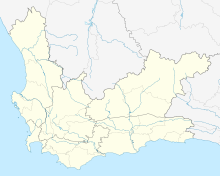Elands bay cave
| Elands Bay Cave | |
|---|---|
| Location | Elands Bay, Western Cape Province, South Africa |
| Coordinates | 32°19′03.5″S 18°19′04.6″E / 32.317639°S 18.317944°ECoordinates: 32°19′03.5″S 18°19′04.6″E / 32.317639°S 18.317944°E |
Elands Bay Cave is located near the mouth of the Verlorenvlei estuary on the Atlantic coast of South Africa's Western Cape Province. The climate has continuously become drier since the habitation of hunter-gatherers in the . The archaeological remains recovered from previous excavations at Elands Bay Cave have been studied to help answer questions regarding the relationship of people and their landscape, the role of climate change that could have determined or influenced subsistence changes, and the impact of pastoralism and agriculture on hunter-gatherer communities.
Renowned archaeologist John Parkington excavated Elands Bay Cave in the 1970s providing vast information of the cave's inhabitants. Parkington frequently used methods of comparing various characteristics in his findings in order to highlight phases of transformations at Elands Bay Cave. Other archaeologists and specialists have analyzed the findings from Parkington. Parkington, Cartwright, Cowling, Baxter, and Meadows (2000), analyzed wood charcoal and pollen data from Elands Bay Cave to explain the environmental change. Klein, in 2001 studied fossil remains and faunal data to indicate hunter-gatherer behavioral and cultural adaptations. In 1999, Cowling, Cartwright, Parkington, & Allsopp researched wood charcoal in order to explain environmental changes. Woodborne, Hart, & Parkington (1995) researched seal bones to construct the timing and the duration of hunter-gatherer coastal journeys. Orton (2006) examined raw materials to produce a lithic sequence for the Later Stone Age in Elands Bay Cave. Lastly, Matthews (1999) used taphonomy and previous research by Peter Andrews to understand the formation and interpretation of micromammals at Elands Bay Cave.
The coastline of Elands Bay Cave has changed dramatically since the end of the Ice Age. A coastal plain once extended some 20 km west of Elands Bay Cave into the sea. Heavier rainfall and different ocean levels allowed Elands Bay Cave to be a lush environment in the past. Testing of faunal remains, bones, and wood charcoals provided evidence of wetter conditions in the terminal Pleistocene. During that time, the environment consisted of colder weather with heavier rain fall which created vegetation that was different than it is today. Now, it has become a drier environment with different species residing there. Rainfall from 9,600 to 13,600 years ago produced 400 mm comparable to today’s 300 mm. More recent environmental conditions near Elands Bay Cave are characteristic of mild weather with an approximated 200–250 mm per year of rainfall occurring every winter. Elands Bay Cave is in close proximity (approximately 3 kilometers) to a rich intertidal environment supporting numerous shellfish species, sea birds, kelp beds, and marine mammals.
...
Wikipedia

